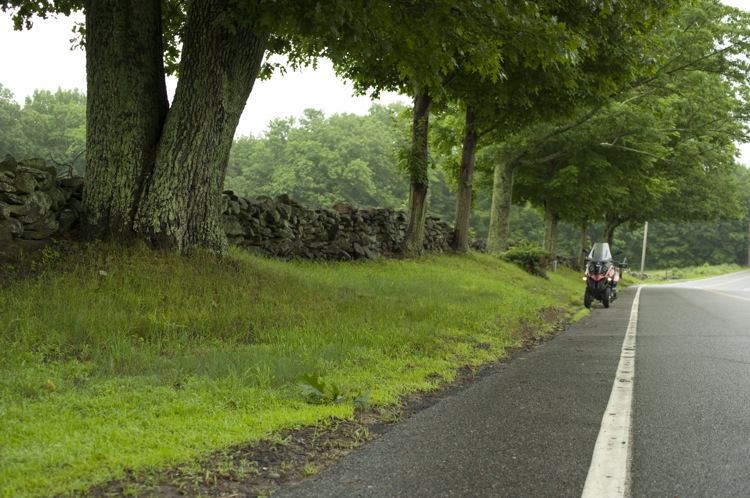Rhode Island and Eastern Connecticut

My trip begins next to an 11-foot-tall green frog. On a spool of thread. On a bridge. Seriously. In the Connecticut town of Willimantic that's how they commemorate a peculiar bit of colonial history. One night in 1754, a terrible racket woke the local citizenry, and fearing an Indian attack, the men gathered, muskets in hand. Once day broke, they discovered the source of the din - hundreds of dead and dying bullfrogs that had been croaking their last notes because their pond had dried up.
Not exactly Paul Revere and Betsy Ross, but the town does deserve some credit for maintaining a sense of humor about the fearsome attack, as four frog-on-spool sculptures (Willimantic was once one of the largest producers of thread in the world and known as "Thread City") grace the bridge into town.

This odd tale is but one of many stitched throughout the histories of Connecticut and Rhode Island, the oft-overlooked states of New England. Maine has its coast and its lobster, New Hampshire the White Mountains, Massachusetts has Boston, and Vermont its postcard scenery and Ben & Jerry's. And Connecticut and Rhode Island? To many, they're little more than rest areas on I-95, a road utterly devoid of character. Pull a Rip Van Winkle while riding a bus on I-95 and upon waking it takes 10 minutes to determine which state you're in. It's that bad. But these two small states (the first and third smallest in the Union) have so much more to offer than food and fuel, and all it takes is an off ramp to find it.
Motorcycle & Gear
Piaggio MP3 500
Jacket: Joe Rocket Airborne
Pants: Joe Rocket Alter Ego
Helmet: Nolan X-602 Replica
Gloves: Held Akira
Boots: Sidi Strada Air
Built to Last
North of Willimantic the town and frogs recede, replaced by quiet back roads and other structures that become constant companions the entire sojourn. In Eastern Connecticut, stone walls are everywhere. They line the roads and run uninterrupted for what seems like miles. At first they look the same, a simple linear collection of stones gathered from land cleared for farming. But as you ride through the area you begin to see the differences - some are little more than mounded piles overgrown with brush and barely visible while others are models of neat precision.
And in an age of big box stores and cookie-cutter McMansions, it's refreshing to see real architecture standing - homes and civic buildings with a character and presence all their own. Here, farmhouses, libraries, factories, and town halls are built of stone, brick, wood, and glass. Many have been lovingly preserved, others woefully neglected. Saltboxes, Cape Cods, Federal Style, Gothic Revival, Queen Anne: a trove of examples can be found. The Town Hall of Southbridge, Massachusetts, just over the border, is a Romanesque marvel, with heavy masonry walls, the rounded tower and the arched windows rendered in red brick. Down the street in this tidy downtown stands the equally imposing fire house. City centers like Southbridge's harken back to an era when towns where defined by their public places - the town hall, fire department, and church spires - which still embody a sense of civic pride that's often missing from modern communities.

A couple of turns and I'm heading back into the woods of Connecticut. The scenery here is tight and compact. There are no vistas reaching to the horizon, no purple mountains' majesty, no big sky, yet Route 169 is particularly fetching as it conforms to the land and the everpresent stone walls - a little to the left, a little to the right, through the woods, past small farms, and alongside serene ponds. The sky widens eastward toward Providence, Rhode Island; and in no time I am on Thayer Street, among the old buildings crammed with ethnic restaurants, motorcycles with their rear wheels to the curb, and sidewalks jammed with young people doing what they've done for centuries - hanging out, meeting friends, and wasting their youth. Ah, the good old days…
Seaside Splendor
I wake the next morning at the Old Court Bed & Breakfast in Providence. An imposing, bright-red, three-story cube of bricks built by Alpheus Morse in 1863, the Italianate building first served as a rectory in 1863 and stands next to the historic Rhode Island Courthouse, now the site of the Rhode Island Historical Preservation Commission. From my vantage point, in a beautiful room with a 12-foot ceiling, the colorful city skyline is set against a charcoal sweep of clouds. Providence is a stately city with layers of history proceeding from long ago, in colonial times. Brown University is here, as well as the well-regarded Rhode Island School of Design (RISD), giving the city a cosmopolitan scope far greater than its size.
